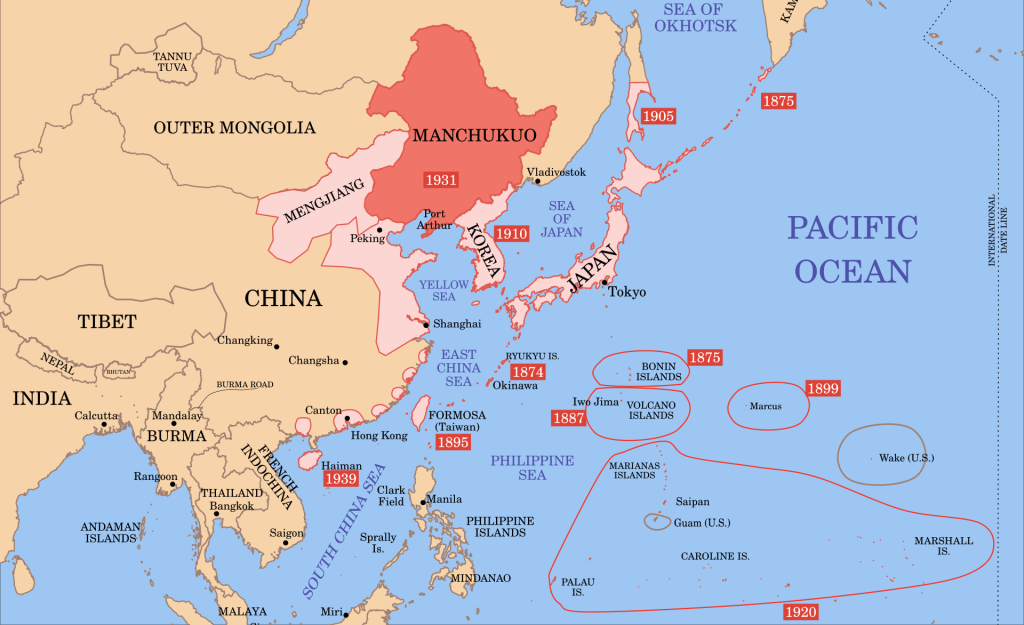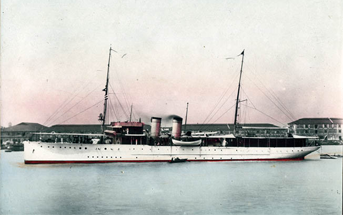Firing the First Shot
“We must somehow maneuver them into firing the first shot.”
President Roosevelt declared prior to the outbreak of World War II.
The “them” he referred to—none other than a vital part of the Axis seeking control of the Pacific –The Japanese.

In 1937 China was invaded by the Japanese.
In 1939 Germany began its assault against Europe and Great Britian.
America watched and waited.
Crippled by the isolationist American public and Congress, who refused to enter another war, the Commander in Chief of the Armed Forces straddled the fine line between his duty to his public and support for the British, Canadians, Dutch, known as the ABCD.
Yet, quiet steps toward U.S. involvement in the conflict were taken as America found itself surrounded by the spreading threat of war.

sign the Atlantic Charter
Roosevelt signed the Lend-Lease Act with Britain, China, the Soviet Union and other Allied countries on March 11, 1941. Therefore, in essence, the United States had entered a de facto state of war against Germany. But the quandary remained how to officially enter the skirmish.
In August of 1941, at the secret Argentin Conference hosted at the U.S. Naval Station off Newfoundland, Roosevelt between Prime Minister Winston Churchill was the first meeting of the two heads of state. The signing of the Atlantic Charter at this meeting confirmed US support for the United Kingdom in the Atlantic waters and beyond. However, as Britain fought against Germany, the US remained helpless until drawn into battle. American could not afford to fire the first shot.
On November 27th of that year, after negotiations with Japan began failing, US Pacific Fleet Commander Admiral Kimmel and US Army’s General Walter Short respectively in charge of the Navy and Army at Pearl Harbor on the peaceful Hawaiian Island of Oahu, were sent the message “This dispatch is to be considered a war warning” also stating, “execute an appropriate defensive deployment.” Kimmel was ordered to “undertake such reconnaissance and other measures as you deem necessary.” Yet, this “vague” communique was misinterpreted, leaving little preparation for the ultimate assault by the Land of the Rising Sun.
On the morning of December 4th, as a prelude to the attack on Pearl Harbor three days later, on December 7th, a message sent by the Japanese was picked up by the US intelligence. “Higashi no kaze ame,” crackled across the airways at Station M, the Navy’s East Coast shortwave monitoring station in Maryland. This phrase translated through Code Purple meant “East Wind, Rain,” the sobering signal indicating all negotiations with American had ‘broken down’. Therefore, Emperor Hirohito, at the advice of his Prime Minister Tojo, would declare war against the United States.
The Japanese must fire the first shot!
Without a doubt, any aggressive action by Emperor Hirohito would anger our sleeping country and insight Congress to declare war. But how to accomplish this task without the US firing first?
The anxious President and his men had not been idly waiting. The question became—
What to use as bait to provoke the first shot?
The “three small ships” directive.
Secretly, FDR agreed to a plan.
A young Naval Officer, Lieutenant Kemp Tolley, was summoned from the Yangtze Patrol to Manila in early December, and assigned the Lanikai, a ship no one had ever heard of before.
That is unless one remembered the schooner used in John Ford’s 1937 Hollywood extravaganza Hurricane, starring the sultry Dorothy Lamour.
Yes, this 83-foot, two-masted schooner was requisitioned into the US Navy. Next, a Spanish-American vintage three-pounder “cannon” and two 30-caliber Lewis machine guns from World War I were mounted on her deck, alongside with other small arms, and declared a warship. Tolly was instructed to set sail and not open his orders until the USS Lanikai was at sea.

The night before their departure, Captain Tolley, along with his unimposing crew composed of a few Navy men and Filipino’s who didn’t speak English, were guided through the mine fields outside Manila. The Lanikai anchored at Corregidor, ready to embark on their mission at sunrise to set out as ‘bait’ hoping the Japanese would fire on them.
As the tides of life would have it, the Japanese attacked the Philippines early the next morning of December 8, 1941. (The same day as Pearl Harbor, December 7th in Hawai’i due to the time zone change.)

This assignment mirrored another private yacht turned man-of-war, the USS Isabel. By this time the Isabel was no stranger to her duties as destroyer yacht. Due to her speed, she was purchased by the Navy for use in WWI. Over the years she had several assignments, mostly in Asiatic waters.
On December 3rd 1941, she and her crew according to the president’s orders, were sent to the “COAST BETWEEN CAMRANH BAY AND CAPE ST. JACQUES” an area in which several Japanese battleships were gathering, not only as a target but to collect information. A few days later, when instructed to return to the Philippines, the yacht was shadowed by a Japanese scout plane, however, the enemy did not fire at her. The Imperial Japanese Navy could not afford to interfere with their months of strategy and preparation for the planned attack on Pearl Harbor and the Philippines.
The Isabel was at port in Manila, the capitol of the Philippines, just as the Japanese bombers arrived, destroying the US aircrafts sitting at Clark Field. She is credited with shooting down one the of Rising Sun’s airplanes during the attack.
Interestingly, eighteen days after Japan declared war on the Philippines, this American stronghold would be abandoned by General MacArthur and declared an “Open City.”
War shows no mercy.

Luckily, the third schooner selected, Molly Moore, half Lanikai’s size, did not have to set sail to lure Emperor Hirohito into battle. He had already set in motion the global struggle that would not end until September of 1945.
The ‘three small ships’ directive was skuttled. The Japanese had fired the first shot – America joined the bloodshed alongside its Allies.
Bravery comes in all shapes and sizes. To sail forth in a small yacht, assigned the secret mission of being the ‘bait’ to lure Japan into firing the first shot – directly at you – to start the war, was a tall order. Some have called it a suicide mission, a one-way ticket, a cause belli, and bait. Any name you give the scheme of the ‘three small ships’ proves only one thing.
When our soldiers, sailors, or airmen enlist, they are committing to more than just a chance to serve their country. They are offering their very lives.

The incredible story told in Kemp Tolly’s book Cruise of the Lanikai is one of the best books I have read. The vivid descriptions of the many islands they visited during their escape and their daily struggle for survival are fascinating and inspiring.
We must not lose sight of the fact that when the Japanese bombed Pearl Harbor,
“A date that will live in infamy,”
and declared war on the United States, they drew us into WWII, the deadliest military conflict in history, a global battle in which destruction, disease and starvation swept across all shores–all countries, causing an estimated 80 million deaths.
Not just on December 7th, but everyday we should be thankful for all the brave men and women who served in World War II, in the Pacific and European Theaters and at home, who fought to provide us freedom and democracy. And give a nod of appreciation to those brave men and women who continue in their footsteps.

Above all, hold to the truth that, at all costs, there should never be another world war.

Excellent presentation
Fascinating!! There is so much we commonly don’t know about WWII